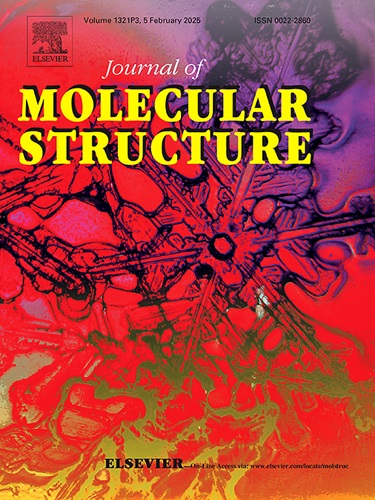Synthesis of novel water-soluble cobalt phthalocyanine decorated with biologically active sodium 2-mercaptoethanesulfonate: Potential anticancer agent
IF 4
2区 化学
Q2 CHEMISTRY, PHYSICAL
引用次数: 0
Abstract
In this work, we have reported on the synthesis, characterization, and biological activity of peripherally tetra-substituted water-soluble cobalt phthalocyanine (CoPc) compound (2) designed with MESNA (sodium 2-mercaptoethanesulfonate) molecules, which are known to be biologically important. The related compound (2) was characterized by Ultraviolet–visible spectroscopy (UV–Vis), Fourier-transform infrared spectroscopy (FT-IR) and MALDI coupled to time-of-flight mass spectrometry (MALDI-TOF MS), Scanning Electron Microscopy (SEM), Energy dispersive X-ray spectroscopy (EDS). The physicochemical properties and drug-likeness parameters of the compound (2) were determined in silico. Molecular docking studies revealed strong interactions between the CoPc compound (2) and cancer-related proteins such as KRAS, TNFR1, ER beta, and p53, suggesting anticancer potential. In vitro cytotoxicity tests demonstrated that CoPc (2) exhibited significant activity against pancreatic (PANC-1) and breast (MCF-7) cancer cell lines. These results highlight the promise of CoPc (2) as a candidate for further investigation as an anticancer agent, particularly for pancreatic and estrogen receptor-positive breast cancers.
具有生物活性的2-巯基乙磺酸钠修饰的新型水溶性酞菁钴的合成:潜在抗癌剂
在这项工作中,我们报道了用MESNA(2 -巯基乙磺酸钠)分子设计的外周四取代水溶性酞菁钴(CoPc)化合物(2)的合成、表征和生物活性,这是已知的重要生物学分子。通过紫外可见光谱(UV-Vis)、傅里叶变换红外光谱(FT-IR)和MALDI耦合飞行时间质谱(MALDI- tof MS)、扫描电镜(SEM)、x射线能谱(EDS)对化合物(2)进行了表征。用硅片测定了化合物(2)的理化性质和药物相似参数。分子对接研究显示,CoPc化合物(2)与癌症相关蛋白(如KRAS、TNFR1、ER β和p53)之间存在强相互作用,表明其具有抗癌潜力。体外细胞毒性试验表明,CoPc(2)对胰腺癌(PANC-1)和乳腺癌(MCF-7)细胞系表现出显著的活性。这些结果突出了CoPc(2)作为进一步研究的抗癌药物的前景,特别是对于胰腺癌和雌激素受体阳性的乳腺癌。
本文章由计算机程序翻译,如有差异,请以英文原文为准。
求助全文
约1分钟内获得全文
求助全文
来源期刊

Journal of Molecular Structure
化学-物理化学
CiteScore
7.10
自引率
15.80%
发文量
2384
审稿时长
45 days
期刊介绍:
The Journal of Molecular Structure is dedicated to the publication of full-length articles and review papers, providing important new structural information on all types of chemical species including:
• Stable and unstable molecules in all types of environments (vapour, molecular beam, liquid, solution, liquid crystal, solid state, matrix-isolated, surface-absorbed etc.)
• Chemical intermediates
• Molecules in excited states
• Biological molecules
• Polymers.
The methods used may include any combination of spectroscopic and non-spectroscopic techniques, for example:
• Infrared spectroscopy (mid, far, near)
• Raman spectroscopy and non-linear Raman methods (CARS, etc.)
• Electronic absorption spectroscopy
• Optical rotatory dispersion and circular dichroism
• Fluorescence and phosphorescence techniques
• Electron spectroscopies (PES, XPS), EXAFS, etc.
• Microwave spectroscopy
• Electron diffraction
• NMR and ESR spectroscopies
• Mössbauer spectroscopy
• X-ray crystallography
• Charge Density Analyses
• Computational Studies (supplementing experimental methods)
We encourage publications combining theoretical and experimental approaches. The structural insights gained by the studies should be correlated with the properties, activity and/ or reactivity of the molecule under investigation and the relevance of this molecule and its implications should be discussed.
 求助内容:
求助内容: 应助结果提醒方式:
应助结果提醒方式:


